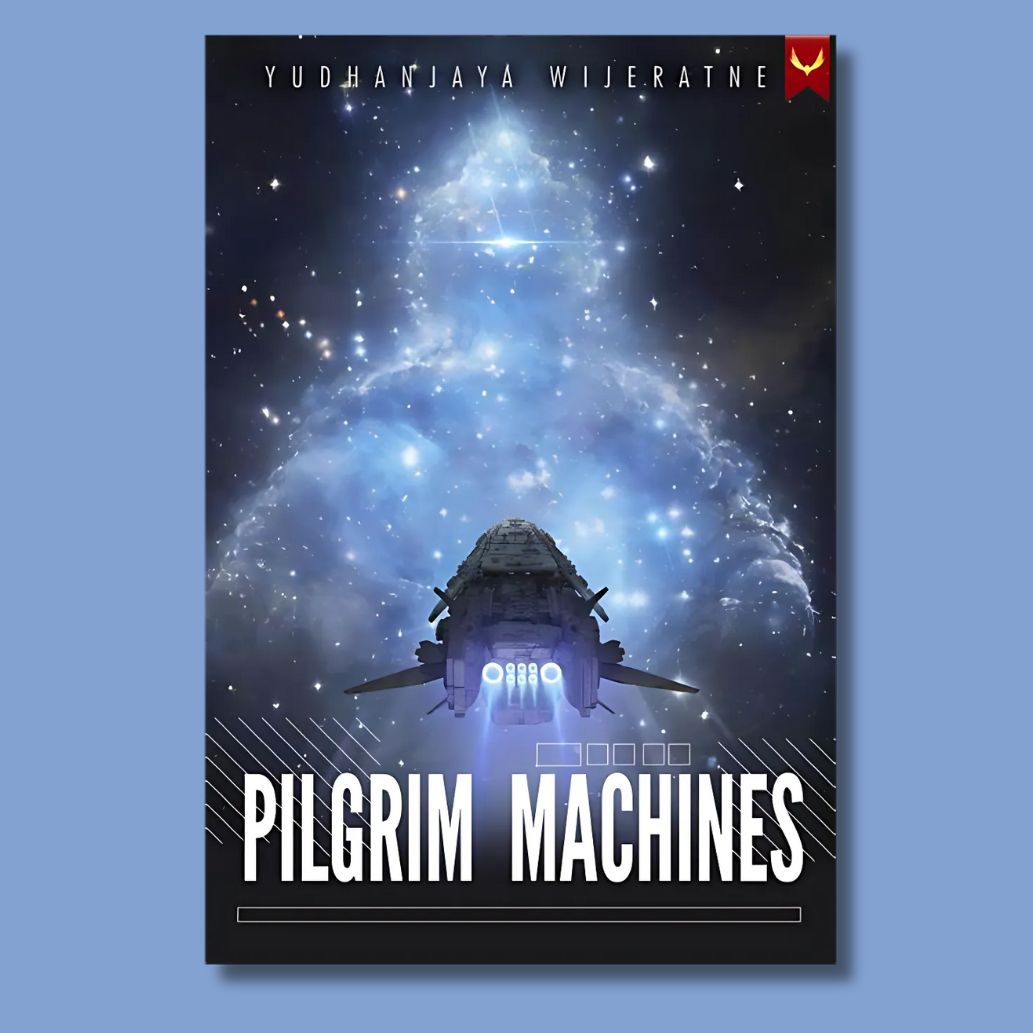
Afterword to Pilgrim Machines
A starship sets out to search for God - or something so close as to make no difference.
If SALVAGE was the nervous wreck making first contact, and PILGRIM was the long, slow slippage into the void, then this one is about hatred. About killing, mostly for money. About angry metal. About being unsure, unable, unkind, and unhinged
Over the years, I’ve been contacted by many fantastic readers who’ve taken great delight in spotting all the references I made in The Salvage Crew and so on. There is hopefully plenty to delight the Easter egg hunter here, but there are also a few things that go beyond being references and become inspiration.
The set theory problem posed by Workshop to our protagonist is actually a variant of something taught in present day Theravada Buddhism in my country of Sri Lanka. Its original source is the Mahavamsa—a long, multi-author history written by monks over centuries.
According to that text, in 248 B.C., King Devanampiya Tissa (‘Tissa Who-is-beloved-of-the-gods’, 247BC-207BC), goes out hunting deer in the vicinity of Anuradhapura. While chasing deer, he is hailed by a monk who appears to be standing on top of a steep pile of rocks or a cliff of some sort.
This is the Arahat Mahinda, the son of the Indian emperor Asoka, part of a delegation sent from India to Sri Lanka to spread Buddhism. Mahinda, before preaching to Tissa, poses this test of sorts, to see if the king would logic his way out of it. The original version involves mango trees, not space stations. When Tissa manages to successfully puzzle his way through it, Mahinda essentially says, okay, great, fine, you have your wits about you; I will teach you my philosophy.
I’m paraphrasing heavily, of course. It took me a few years after The Salvage Crew to realize that this was actually a set theory problem, at which point it became very interesting. It’s a pretty decent test of intelligence, I think.
Similarly, the verse that workshop shares is my translation of the Karaniya Methta Suthraya (Karaṇīyamettā Sutta), which is part of the Pali Canon of Theravada Buddhism. I have attempted to deliberately inject a slight amount of linguistic drift without compromising on the translation.
For legal reasons that have to do with the current sorry state of laws in Sri Lanka, I am obliged here to say that Nyogi Buddhism is entirely my own creation. It is fictional. Absolutely no ill intent should be inferred toward any religion currently operating in Sri Lanka by a fictional variant that is set thousands of years in the future. Where it has taken from the present-day Buddhist canon, as in the example outlined above, it is inspiration—and does not claim to be an outright successor of any kind.
I started writing this novel almost immediately after finishing the manuscript for Pilgrim Machines. At the time I was thinking about this game called Dust 514 by CCP - the game studio, not the former Soviet Union.
Dust 514 was released in 2013. It was a companion game to the massively successful EVE Online. The idea was that while Eve put you in space, Dust would let you play the role of mercenary ground troops on the planets—the actual planets that you as EVE players were fighting over in that same universe.
I remembered the hook in the plot line, which was this conceit that you were essentially transferring your consciousness between the ship and between the soldier on the ground. This seemed like a very interesting setup, particularly because it would work perfectly in my world of The Salvage Crew.
And so I began. Dust 514 was shut down, I think, somewhere in 2016, but I would like to thank it for that spark. So to the fantastic team at CCP, thank you for years and years of not just entertainment, but some inspiration.
Bunny’s poem is by Rumi, the famous 13th century Persian poet, jurist, theologist, ascetic, and Sufi mystic. Or rather, just Rumi. One of that caliber does not need labels.
Potato sometimes mentions soundtracks; these are from Mick Gordon’s work for Doom Eternal. You can guess what I was listening to as I wrote. Part of my playlist included “Paradise Eve” by Bring Me the Horizon, which was in part inspired by Gordon’s work.
This whole Hestia Alpha business. That name has been stuck in my head for a very long time, and I believe it comes from Battleships Forever, a game made by Singaporean game designer Sean “TH15” Chan. It was a top-down spaceship battle where you could customize your ships, inspired by Warning Forever by Hikoza.T.Ohkubo. Back when I was making games (in the GameMaker and YoYoGames.com days), Battleships Forever was the title I looked up to—not only as a demonstration of what that engine could do, but also what good design could be. The Hestia is a ship in that game.
I believe Sean works at Bungie now. It’s just so amazing to see people’s dreams come true. Sean, if you ever read this: I still have a pen drive with the game files on it. Please make a sequel someday. I will be first in line to buy it.
I’d also like to thank RamenStyle, from YouTube, for the absolutely fantastic video about what happens when Tarkov players get into Helldivers. It was an absolute blast watching the professionalism on display. We who were there in Malevolon Creek share a common unity of purpose.
On that note, every Salvage Crew book has been an opportunity for me to experiment with AI in different ways. During the writing of this book, I fractured my hand. It hurt like hell.
I was hoping to get through life with only one fractured hand, but it turns out two were in the cards. So I had to write this book with wires connecting my bones together, a hell of a lot of painkillers, and a cast that actually hurt more than the fracture.
Fortunately, I was able to work my way around this problem. With the use of the OpenAI Whisper model (hosted locally, running on my GPU), I was able to speak at my microphone and have my words recorded and transcribed as I spoke them.
This was revolutionary. Voice to text has never really worked well for my accent. I find that a lot of software is utter garbage at handling South Asian voices, and so it was a pleasant surprise to realize that I could actually continue my story. With a very small three button keyboard that I programmed, I was able to make this process relatively painless.
I have a feeling that being able to write this way, even though it felt utterly alien at first, kept me sane. I’ve since begun building these little keyboard microphone setups for a few friends who also have issues with their hands. It’s a marvel of accessibility.
At some point during the writing of the book, I realized that I was essentially doing something similar to what Ian Banks did with the Culture. Not in terms of the world or the stories, of course; the world of the Salvage Crew is almost an antithesis, a dark mirror of the Culture’s gentle anarchic post-scarcity socialism. But in terms of writing different stories in the same world, where some of them are clearly affected by events in the other. The Culture has sustained me greatly over the years, and in some ways it felt like being able to pay homage. And for that I am thankful.
I would also like to thank Dennis E. Taylor for the Bobiverse. I had long since internalized that space combat would happen at immense distances almost like naval conflict, completely out of line of sight. But I admit I was a little rusty at thinking about the obvious second-order repercussions until I went on my habitual Bobiverse re-read. That approach to space combat got my brain working again.
There’s also a little bit of the SCP wiki in here. At some point, as I started thinking about what police structures and even secret police structures might look like, I found myself writing in a reduced version of familiar style: that coldly rational, dissociated approach of an agent documenting a problem, attempting to quantify and contain threats. All hail the Scarlet King.
I can’t exactly pinpoint the moment the Shutter Island vibes started to creep in, but once they were there, it seemed like this was the only way this story could have been told.
And, last but not least, many thanks to Rhett and Steve of Aethon, who keep publishing these books. Publishing is often a difficult and frustrating industry. People who are easy to work with, and welcoming toward these experiments of mine, are genuinely rare.
The rest of it, I’m afraid, is all my fault. I hope you enjoyed it.
– Friday, 29th, November 2024 Colombo, Sri Lanka.
